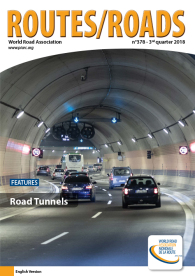Feature
Air Velocities Permitted in Road Tunnels and Other Requirements for a Safe Escape Route in Case of Fire
Providing a safe escape route in case of fire is a key factor for road tunnel safety. In the Netherlands, road tunnels are usually equipped with an escape gallery between tunnel tubes. Access to the escape gallery is provided by emergency exits, usually located at intervals of 100 m in every tube. Pressurisation of the gallery prevents the smoke from the incident tube from entering the gallery through open emergency exit doors. The trend to build longer tunnels provides a challenge for the pressurisation system: a higher ventilation capacity is needed to keep the gallery free of smoke. This also results in higher air velocities within the gallery and through the emergency exits when the doors are opened. Because excessive velocities can hinder or even block the evacuation, a test was performed by Rijkswaterstaat, with over a hundred test participants, to examine if people were still able to enter the gallery against higher velocities and were able to walk through the gallery to the exit to the outside. Based on the results, the requirements in the national tunnel standard were updated. Moreover, a methodology and software tool were developed to verify and validate a design for the pressurisation, on the basis of these updated requirements. This article gives an overview of these developments.

